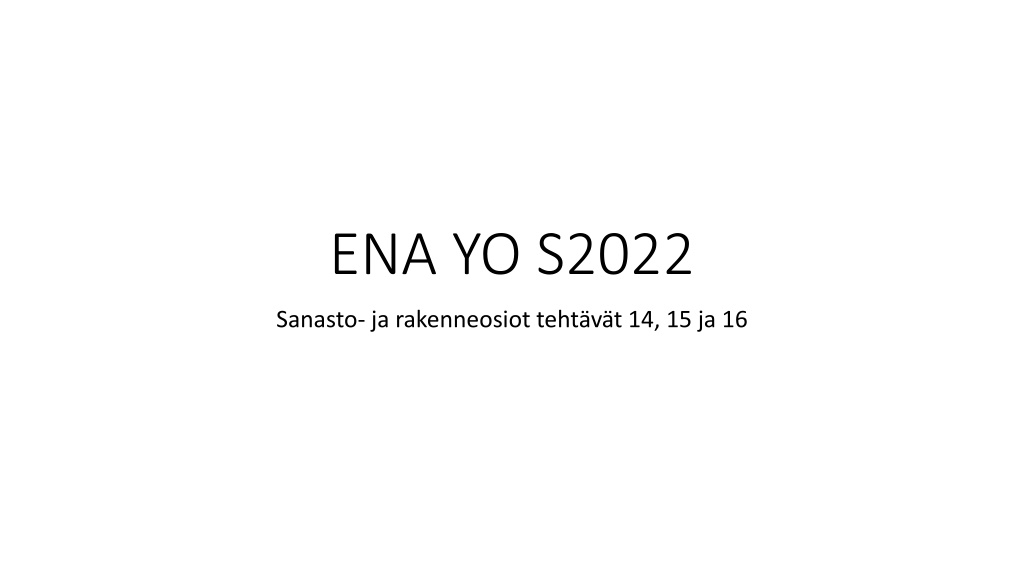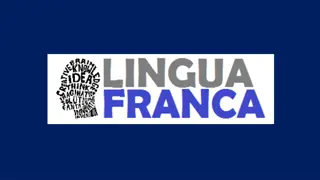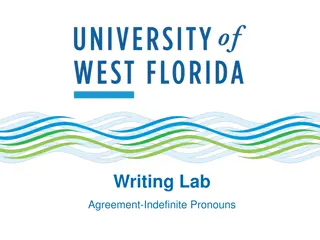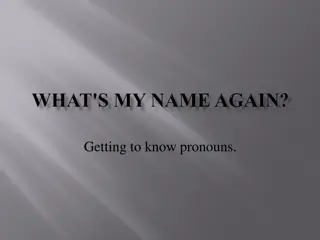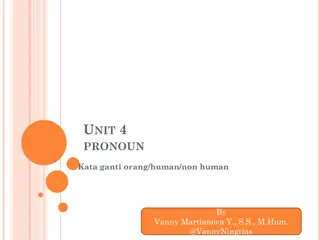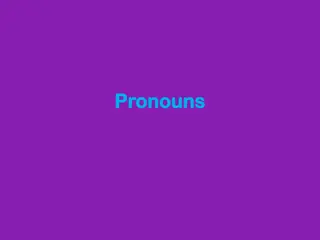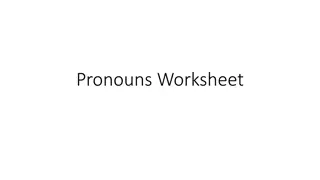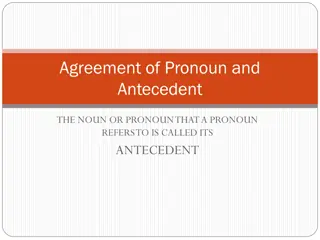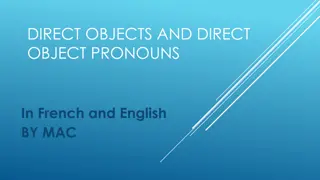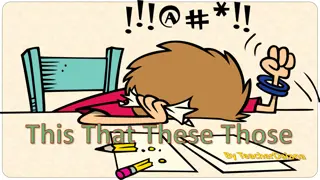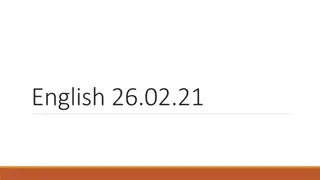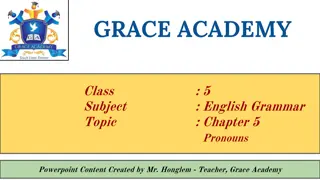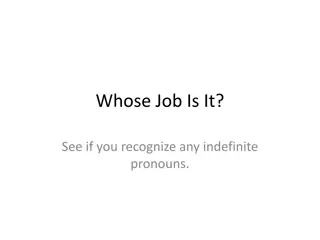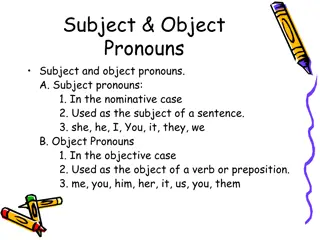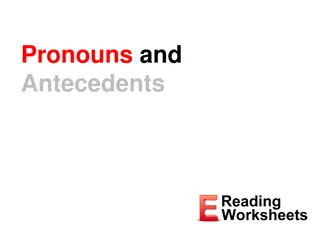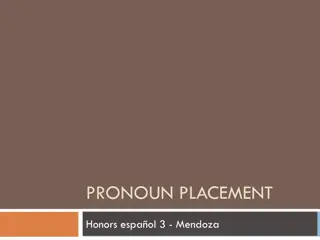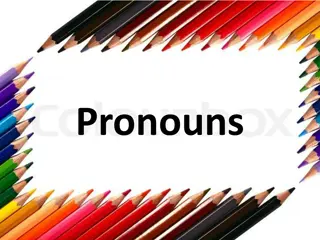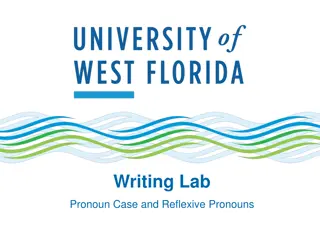Evolution of Gender-Neutral Pronouns in English: Singular "They
The text discusses the evolution of using gender-neutral pronouns in English, particularly focusing on the acceptance and adoption of singular "they." It highlights the historical resistance, societal shifts, and linguistic authority approvals that have led to the emergence of "they" as a gender-neutral pronoun. The narrative emphasizes the growing acceptance and acknowledgment of diverse gender identities within language evolution.
Download Presentation

Please find below an Image/Link to download the presentation.
The content on the website is provided AS IS for your information and personal use only. It may not be sold, licensed, or shared on other websites without obtaining consent from the author. Download presentation by click this link. If you encounter any issues during the download, it is possible that the publisher has removed the file from their server.
E N D
Presentation Transcript
ENA YO S2022 Sanasto- ja rakenneosiot teht v t 14, 15 ja 16
Teht. 14 People Have Invented More Than 200 Gender-Neutral Pronouns. Here's Why They Is Here to Stay What words could replace the underlined words in the text (material 9.A)? Choose the alternative that best fits the context and conveys a similar meaning. It is a well-known truth that so long as English is changing, there will be people who are 14.1 belly-aching about it, warning that if things keep going as they are, the language will soon be on life support. Critics feared for the future when people started using contact as a verb in the 1920s and when they embraced text-speak like OMG in the 2000s. And, they have 14.2 lamented the usage of one pronoun in particular: singular they. For centuries, poets and pundits have observed that English is missing a word: a gender-neutral, third-person pronoun that could be used in place of he or she when gender is unknown or irrelevant. They has long been proposed as the answer. But grammarians have considered singular they unfit for print, holding fast to the rule that educated people use they only as a plural. All the while singular they has been 14.3 lurking in the background. And now it s moving to the fore. A driving force has been the LGBTQ community, which has embraced singular they not only to include both men and women but also to refer to non-binary people who identify as neither. That has added social conservatives to the word s 14.4 detractors, but has also given it steam. The new binary-busting usage made it the American Dialect Society s Word of the Year in 2015 and then Merriam-Webster s in 2019. This also helped inspire linguistic authorities to put down their red pens. In 2015, the Washington Post copy desk announced that the paper would start allowing singular they. In 2017, the Associated Press Stylebook approved it when alternative wording is overly awkward or clumsy. The same year, the Chicago Manual of Style said that if an individual prefers to be referred to as they, then they is the preferred style. And each evolution has added to the sense that this usage isn t just 14.5 convenient, it s also grammatically okay.
It is a well-known truth that so long as English is changing, there will be people who are 14.1 belly-aching about it, warning that if things keep going as they are, the language will soon be on life support. Critics feared for the future when people started using contact as a verb in the 1920s and when they embraced text-speak like OMG in the 2000s. And, they have 14.2 lamented the usage of one pronoun in particular: singular they. 14.1 14.2 agitated praised hushed grieved delighted avoided
For centuries, poets and pundits have observed that English is missing a word: a gender-neutral, third-person pronoun that could be used in place of he or she when gender is unknown or irrelevant. They has long been proposed as the answer. But grammarians have considered singular they unfit for print, holding fast to the rule that educated people use they only as a plural. All the while singular they has been 14.3 lurking in the background. And now it s moving to the fore. A driving force has been the LGBTQ community, which has embraced singular they not only to include both men and women but also to refer to non-binary people who identify as neither. That has added social conservatives to the word s 14.4 detractors, but has also given it steam. The new binary-busting usage made it the American Dialect Society s Word of the Year in 2015 and then Merriam-Webster s in 2019. 14.3 14.4 surficing users hiding critics abiding experts
This also helped inspire linguistic authorities to put down their red pens. In 2015, the Washington Post copy desk announced that the paper would start allowing singular they. In 2017, the Associated Press Stylebook approved it when alternative wording is overly awkward or clumsy. The same year, the Chicago Manual of Style said that if an individual prefers to be referred to as they, then they is the preferred style. And each evolution has added to the sense that this usage isn t just 14.5 convenient, it s also grammatically okay. 14.5 accessible manageable inappropiate
Teht. 15 Dungeons and Dragons: The origin Once upon a time, Dungeons and Dragons was published by a company named TSR, in a magical realm named Wisconsin, where the hills rolling / rolls / roll like green waves to the horizon, where the cheese is bright / a bright / the bright orange of the sunrise, and the winters are long and dark as death. Dungeons and Dragons was created at / in / by a brace of midwestern mages named Gary and Dave, and the tale of the game s journey from a Lake Geneva basement in 1972 to the cultural institution there / it / that is today is one of the great stories of gaming. the hills roll like the bright orange of the sunrise created by Gary and Dave it is today
Dungeons and Dragons grew into / out of / as of the fortuitous meeting of Gary Gygax and Dave Arneson. Gamers back in the 60s and 70s often named their gaming groups, a bit like acting troupes or biker gangs. Gary Gygax, for example, was involved in a group called the Castle & Crusade Society. The society have / having / had ranks and peerage, exactly like a medieval realm. The king , ironically, was a 14 years / a 14-year-old / 14-year olds but there was also a certain baron from Minneapolis named Dave Arneson. jostakin = out of The society had The king was a 14-year-old (adj.)
The evolution of the Dungeons and Dragons itself began with Chainmail, a game written by Gary Gygax and Jeff Perren to have simulated / to be simulating / to simulate medieval combat. However, / Still, / Above all, at the end of the game, there was an extensive supplement having described / describing / to be describing the application of the rules to fantasy. The fantasy supplement provided rules for magic swords, monsters, and spells with names like Lightning and Fireball. to simulate = jotta se j ljittelisi; j ljitellen However, = kuitenkin describing the application = kuvaten sovellusta
When Dave Arneson read the Chainmail fantasy rules, he adapted them to a fantasy world of his own creation, Blackmoor a setting inspired by the Lord of the Rings universe combined with elements of Arneson s own imagination and various mechanics pulled from / by / to other games. The premise was simple: players had potrayed / were potraying / would potray only a single character (an idea he lifted from a game called Braunstein), exploring underground dungeons where they were to face perils and puzzles. Both the characters and the story were to persist from session to session, with characters working cooperatively and improving over time. Arneson s own imagination and various mechanics pulled from (jstakin) The premise was simple: players would potray only a single character (aikamuotoparit)
In the fall of 1972, Arneson drove down to Lake Geneva, Wisconsin from Minneapolis to run Blackmoor for Gary Gygax. Gygax was blown away by the game, and in / over / within weeks requested the rules from Arneson. He had mailed / were mailed / was mailed 18 hand-written pages. Gygax took them and expanded them to fifty pages, and began testing the game with his children, Ernie and Elise. Gygax named the campaign he was running Castle Greyhawk. Soon, Gary and Dave had codified all their ideas and experiences into a ruleset and / what / they titled Dungeons and Dragons. It would prove to be a revolution. within weeks = viikkojen kuluessa / sis ll He was mailed h nelle l hetettiin (passiivin imperfekti) Gary and Dave had codified all their ideas into a ruleset (which) they titled
Teht. 16 Read the text carefully and fill in each gap in English according to the clue and using the correct form in each sentence. Dungeons and Dragons: The birth Ironically, D&D was unable to find a publisher, so Gygax decided to publish it himself. D&D sold 150 copies in its first month, and (kes n menness ), another 1,000 copies. For the first years of (exist) , the game was difficult to find, and because of that, pirate photocopies of the rules (proliferate) (The game also cost $10, which (consider) an exorbitant amount of money at the time for a game, which may have had something to do (prepositio) all the intellectual property theft.)
